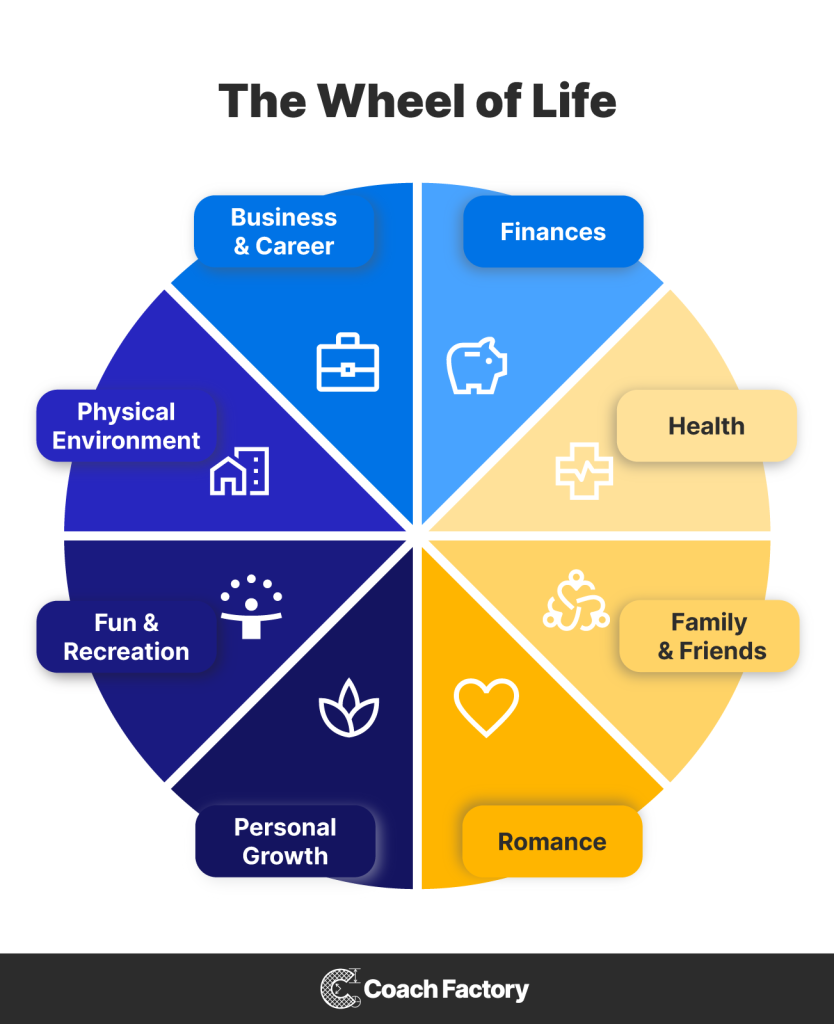Imagine your client sits across from you, visibly overwhelmed, struggling to articulate the chaos brewing in various corners of their life. They’re a swirl of emotions — enthused about their progressing career, but distressed about dwindling personal relationships and a non-existent fitness routine.
This is where it helps to have a diverse set of tools and assessments — like the Wheel of Life.
It’s not just a chart or a simple diagram, but a mirror reflecting the intricate balance (or imbalance) of one’s life. For many, this visual tool produces an a-ha moment that brings instant clarity to the chaos.
Grab your copy of the worksheet now to reference as you continue reading the post.
As coaches, introducing clients to the Wheel of Life isn’t just about mapping out life areas; it’s about igniting self-awareness, prompting transformation, and guiding journeys towards equilibrium. So let’s dive in and explore the power and potential of this pivotal coaching tool.
What Is the Wheel of Life?
The Wheel of Life has its roots in Buddhist philosophy. That said, its modern incarnation is a powerful reflective instrument for anyone seeking balance, fulfillment, and a deeper understanding of their life’s complex landscape.

At its core, the Wheel of Life divides an individual’s existence into eight distinct — but interconnected segments:
- Business and Career: Focuses on professional development, job satisfaction, and career goals to help to align work-life with overall life purposes.
- Finances: Addresses money management, saving, investing, and financial stability and alignment with personal values and life goals.
- Health: Emphasizes physical, mental, and emotional well-being by promoting habits and choices that lead to a healthier lifestyle.
- Family and Friends: Concentrates on relationships, communication, and connections within family and friendships that nurture positive and supportive social interactions.
- Personal Growth: Targets self-awareness, confidence, learning, and personal development to increase individual potential and growth.
- Romance: Deals with love, intimacy, and connections in romantic relationships to help nurture fulfilling partnerships.
- Fun and Recreation: Focuses on leisure, hobbies, and activities that bring joy and relaxation
- Physical Environment: Addresses the living or working environment to create spaces that are harmonious, functional, and aligned with personal preferences and needs.
In life coaching, the Wheel of Life is more than just an intake tool; it can guide and inform the entire coaching journey, beginning with the client opening up and ending with personal transformation. It aids coaches in structuring their sessions and uncovering the hidden needs, desires, and challenges your clients face.
By engaging your clients in an honest assessment of their lives, you can help them recognize disconnects and work towards a more balanced existence.
How To Introduce the Wheel of Life to Your Clients
Introducing the Wheel of Life to your clients requires a careful approach to prepare them for the transformative journey they seek. Here’s how you can navigate this process.
Explain
Start by describing what the Wheel of Life is, emphasizing its visual representation of different life areas. Use simple language and provide examples that can make the concept relatable.
Align
After introducing the concept, align the Wheel of Life with your client’s unique goals and values. Ask open-ended questions to understand what they hope to achieve and explain how the Wheel of Life can serve as a roadmap to those aspirations.
Assess
Every client may not find the Wheel of Life suitable for their needs. Assess their readiness by considering their responsiveness and openness to the concept. Tailor your explanation and approach based on their situation, recognizing that it may not be the right tool for everyone.
Address
Some clients may have reservations or misconceptions about the Wheel of Life. They might see it as overly simplistic or irrelevant to their issues. Address these concerns by acknowledging their validity and providing examples of how the Wheel of Life has been effective for others. Reassure them that it’s a flexible tool tailored to reflect their unique life and challenges.
By taking the time to introduce the Wheel of Life thoughtfully and responsively, you can set the stage for deeper exploration and growth in your coaching sessions. It’s not just about explaining a concept; it’s about forging a connection that empowers your clients to see their lives from a new, more insightful perspective.

Using the Wheel of Life in Your Coaching Practice
The Wheel of Life is a valuable tool for coaches aiming to guide clients toward balanced, fulfilling, and intentional lives. It highlights strengths and areas for growth while offering a balanced perspective. Using this tool in your practice will boost client engagement and improve accountability in the coaching process.
Here’s the framework for using the Wheel of Life in your coaching practice.
1. Introduce the Exercise
Before meeting your client, share the Wheel of Life template and ask them to reflect on their life areas. Answer any questions they may have to ensure they understand each section. Remember to remind your client that there are no right or wrong answers. Giving your client time to explore their feelings and needs privately will encourage them to be more honest with their answers.
2. Conduct an Evaluation
Once the session begins, discuss your client’s initial thoughts on the wheel. See how comfortable they were completing the assessment because a simple misunderstanding could change their results.
Then, discuss why the ratings they gave for each section while exploring what’s working and what isn’t. Be sure to provide feedback to help them see their life in a new light.
3. Probe to Uncover More Details
Probing will go beyond the surface by using open-ended questions to explore underlying beliefs and patterns. Look for connections across different areas and work with your client to develop action plans that align with their goals and values.
4. Summarize and Schedule Follow-up Sessions
At the end of the session, summarize any new insights discussed and review the action plan with your client. Then, schedule follow-up sessions to track progress and maintain accountability.
Have your client repeat the assessment after reaching set milestones in their action plan.
Free, Printable Wheel of Life Coaching Worksheet
The Wheel of Life is unique because of its relevance across different fields. Whether you’re a life coach, career coach, or fitness coach, the principles remain the same, making it a flexible and powerful tool. The visual and interactive nature of the Wheel not only aids in building a deeper understanding between the coach and the client but also nurtures a sense of commitment and investment in personal growth.
Adding this powerful assessment to your toolkit can help you build a coaching system that will produce consistent results for your clients. Download and print the Coach Factory Wheel of Life Worksheet to help your clients visualize areas for improvement so you can explore them together in your next session.


